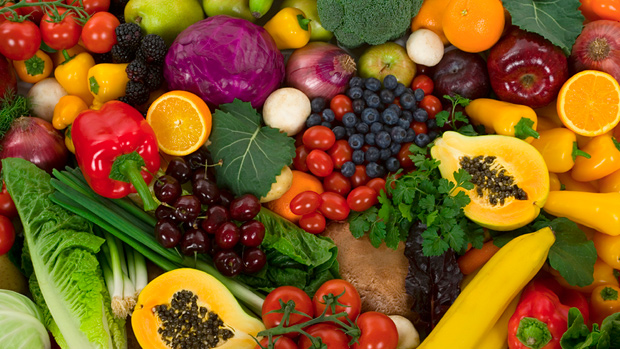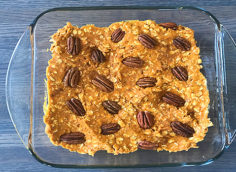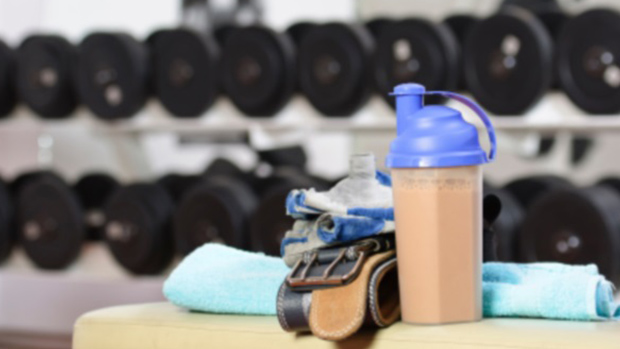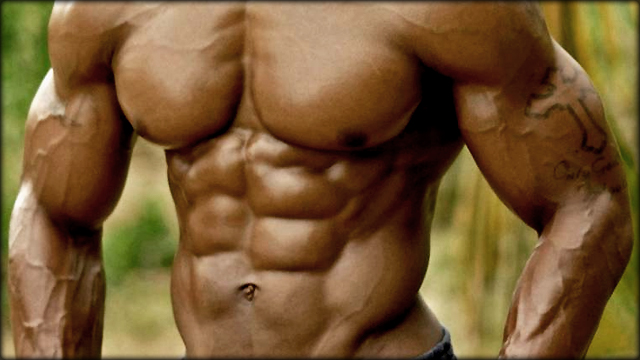Sure, the corner pharmacy holds a great deal of potent drugs. Sure, some of these drugs hold great interest for many people seeking health, performance and physique-enhancement. But we didn't evolve depending on such things. For the 40,000-100,000 years we've been on this planet (depending upon one's interpretation), our genes have been selected to interact with the forest as our pharmacy. And only recently are we fully coming to grips with the full power of this interaction. Perhaps it's time we reconsider the advantages of living "down on the farm".
With the huge variety of dietary supplements and pharmaceuticals discussed in bodybuilding and fitness mags these days, it can be easy to forget about food. Food is not only a source of energy (kcal) or the classic macro- and micro-nutrients (protein, carbs, fats, vitamins and minerals); many foods also possess pharmaceutical properties of which physique conscious athletes should keep abreast.
We're not talking a little vague antioxidant action or slightly reduced risk of colon cancer here - we're going to look at some foods that may, over time, actually act as mild "partitioning" or recovery agents as part of a comprehensive dietary regime! I doubt you'll find exercise-specific data on all -or even most of - these foods' benefits, so we'll speculate from some pretty juicy indirect data when needed.
If you've been hoping to make a few sustainable dietary changes to increase variety and health - and even improve your physique–you may be interested in this ongoing review. Stay mindful that not all these foods are for everyone: allergies, intolerances and even conditions like kidney stones come to mind as potential contraindications (no-no's). Use some common sense, eh?
This mini-text may not be comprehensive but it does have an unusual slant toward strength athletes. That's not something you're likely to see at the local bookstore. You will see a definite focus upon fruits and vegetables, legumes and food-source botanicals because they tend to be the most overlooked, but we'll also branch into other "naturally functional foods" as chapters are added.
Bon apetite!
Chapter One: Fruits and Vegetables
Where better to start than the very foods upon which good old mum harped so incessantly? Do you remember those childhood days? I was a master of covertly disposing of all sorts of vegetables at dinnertime so I could go out and play some aggressive Nerf football, full contact tag (which we called "murder" because it took place at night and was more of a team-based sniping operation), or resume my nerdy role as Dungeon-master for the neighborhood Dungeons and Dragons party I recruited (uh, yes, I'm that dichotomous).
So, rather than offer tricks to dispose of dinnertime veggies (like the old "tomato slice Frisbee under-the-fridge technique"), I'm going to concede to mom's nagging and help all of you come to value the botanical bounty that we enjoy nowadays.
Pineapple
Although there's not exactly a plethora of data floating around Medline regarding this, there is some evidence that bromelain, the phytochemical in pineapple, can lessen exercise-induced muscle "damage" - at least as measured by elevated creatine kinase (CK).(33) A more recent study by Stone and colleagues,(2002) however, basically says any recovery effects don't extend to pain, loss of range-of-motion, or loss of concentric peak torque. Still, along with the potassium and other nutritional goodies in pineapple, any recovery-facilitating effect is itself worth the occasional inclusion of pineapple at breakfast. It can be blended into a mid-workout shake or even put on a chicken breast sandwich (one ring isn't too high in carbs and adds moisture and flavor).
Grapes
Similar to pineapple, grapes appear to also possess the ability to decrease CK, apparently by way of their seeds' anti-oxidant action.(3) If this holds true for skeletal muscle post-exercise, then the heart-healthy antioxidant activity of grapes, which we hear about so often, may also help in bodybuilding-related ways. And let's not forget that they're a great source of the fascinating substance resveratrol that is neuro-protective against oxidative damage.(29) This compound has low-toxicity, at least in rodents,(13) and allows lucky lab animals to live 70% longer.(12) This stuff still numbs my brain (even as it protects it)!
Blueberries, Rapsberries, Strawberries, Blackberries
Hey, anything sold as a dietary supplement in its own right (e.g. blueberry extracts) must be intriguing to some people. The antioxidant rush from these sweet additions to protein shakes and oats everywhere has become widely touted in "super-food" type books. Of interest to hard training athletes are the published neuro-protective effects (19) ?very interesting to those power athletes who are so rightfully concerned over nervous system recovery.
Even muscle tissue may benefit from a hypertrophic effect! Rats with previously damaged nerves were shown to actually gain muscle mass and strength from proanthocyanidin, a blue polyphenol relevant to our discussion.(2) What's more, different berries and related antioxidants appear to scavenge different free radicals.(34) Thus a bag of mixed berries covers multiple bases. Buy mixed frozen berries and store them in a freezer while they're cheap and in-season; there's no real difference versus fresh..(22) Like juice? Naturally deep-colored berry juice has more phenols, flavanoids and anthocyanins to help combat things like liver cancer (16) even if your main goal is just better training recovery.
Apples
I've harped on the benefits of this food before. Three apples per day can result in significant weight loss over 12 weeks.(9) A great satiating pre-meal "anti-appetizer" (i.e. way to slow down and moderate blood sugar) (11), apples also provide a few grams of fiber, a favorable glycemic index and even improved biological functioning. There is at least one report that middle-aged men who consume five apples per week have better lung function (FEV1) compared to those who don't partake.(7) Although lung function doesn't typically limit athletic performance, this is nonetheless cool.
Red pepper (capsaicin)
There is mounting evidence that red pepper, particularly when consumed with caffeine, is quite the fat loss food/ spice. (Although hot pepper is not to be overdone as there is some evidence relating chronically high intakes (9-25 peppers daily) to stomach cancer.[17]) It suppresses appetite and has significant thermogenic properties.(36-38) The net result is easier achievement of negative energy balance. The seeds and "spines" running along the inner edges of a hot pepper can be particularly blazing. Does this mean spicing-up meals with red pepper while on Red Bands will melt your keyboard as you try to post on the T-Nation Forum? Actually no, but this is one intriguing pharma-food.
Broccoli
If you haven't heard of the wonders of broccoli, you may want to relocate? out from under your rock. With bountiful phytochemicals,(5) including cancer-fighting indoles (also found in cabbage and cauliflower), this is great stuff. Remember that cruciferous veggies provide indole-3-carbinol which has been shown to be anti-estrogenic.(20, 21) And let us not forget the soluble fiber and very few kcal that make broccoli a filling, satisfying boon for dieters. It's a nice big guiltless side dish with grilled chicken, it's a substantial salad improver, and it's even something dip-able to replace chips when eaten raw. I wouldn't personally start eating it by the bushel due to the gassy side effects but a slow progression toward more, in a diet that currently lacks veggies, is a winning move. There's plenty more to discuss but suffice it to say that mom was right: eat your friggin' broccoli.
Tomatoes
Fruit or vegetable? It's an ongoing discussion although they are technically a fruit. I used to hate them but then I realized there are many ways to skin a cat. Ultra-thin slices (e.g. sandwiches, specialty pizzas), the sun-dried type (great in stir fries) and lower-sodium sauces (marinara, salsa, etc.) are alternatives to whole tomatoes. This natural source of lycopene appears to be quite the boon to those at risk of heart and prostate problems.(18, 35) Lycopene also reduces the inflammatory status of colitis in lab animals.(26) Tomatoes are even being seriously considered as a part of actual cancer treatmenti in people.(23) Plus, the potassium helps offset the sodium load so easily consumed in today's processed environment. Lastly, try warm, lower-sodium tomato soup as an (anti-) appetizer that can slow feeding rate and total kcal consumption when dieting.(27)
Carrots (and friends)
Ah yes, the "eyesight vegetable". But they're not just for your eyes. The beta-carotene (a vitamin A precursor, yes, but beneficial in its own right), enhances blood antioxidant capacity and that's especially good during physical stress and trauma when carotenoid levels otherwise fall.(4, 15, 24) Did you know that less than 20 minutes of resistance exercise (at 75% max) can drive-up oxidative damage? (25)
Here are just a few other beneficial possibilities: Carrots and pumpkin have a beneficial impact against chronically high blood sugar (as HbA1c).(30) And since I mentioned pumpkin, did you know the oil from its seeds helps many aspects of chronic arthritis in lab animals- even the resulting edema?(8) Carotenoids have an inverse relationship to inflammation and can prevent cell damage.(15, 31) Want a double-dose of alpha- and beta-carotene in a naturally-correct package? Try purple carrots!(1) Cook your carrots or eat them raw, their glycemic effects don't really change.(32)
And carotenoids go beyond just beta-carotene, so it's a good thing there are accompanying goodies already packaged for you in those carrots. These phytochemicals work in unknown combinations. That's why it's best to forgo straight supplemental beta-carotene. You may have heard about the disaster regarding research that involved plucking beta-carotene away from its fellow phytochemicals. The reduced lung cancer offered by carotenoid-rich plants was not only lost but that solitary beta-carotene actually worsened the risk in smokers.(14) Ugh! In this case, it's not nice to meddle with Mother Nature.
You can see that fruits and vegetables are no joke. Their phytochemicals act as hormone inhibitors, potent antioxidants, tissue protectors, ergogenic aids in some circumstances, enzyme inhibitors, cholesterol modifiers, blood clot inhibitors and so much more.(5) Hence, they reclaim their place as near-pharmaceutical substances, much like dietary supplements can be. Eating a wide variety is the key to avoid excessive accumulation and gain protection from any one toxin or nutrient.(10)
You see, toxins inescapably permeate the food supply and nutrients themselves have tolerable upper limits of intake. Spread your dietary boundaries beyond the 15 to 20 foods that you currently consume!
Hey, plants were around for about a billion years before we were so it's no wonder that our very blueprint seems to need them for a strong, healthy, functioning body. Do yourself a favor this week and buy a bag of a fruit or vegetable that suits you.
Chapter Two is coming soon to this mini-text and will feature beans and nuts.
References and Further Reading:
- Alasalvar, C., et al. Comparison of volatiles, phenolics, sugars, antioxidant vitamins, and sensory quality of different colored carrot varieties. J Agric Food Chem. 2001 Mar;49(3):1410-6.
- Ambrogini, P., et al. Effects of proanthocyanidin on normal and reinnervated rat muscle. Boll Soc Ital Biol Sper. 1995 Jul-Aug;71(7-8):227-34.
- Bagchi, D., et al. Molecular mechanisms of cardioprotection by a novel grape seed proanthocyanidin extract. Mutat Res. 2003 Feb-Mar;523-524:87-97.
- Boosalis, M., et al. Acute phase response and plasma carotenoid concentrations in older women: findings from the nun study. Nutrition. 1996 Jul-Aug;12(7-8):475-8.
- Brown, J. Nutrition Now. 2002; Belmont, CA: Wadsworth/ Thomson Learning. pp.21-1 - 21-14.
- Burns, J., et al. Plant foods and herbal sources of resveratrol. J Agric Food Chem. 2002 May 22;50(11):3337-40
- Butland, B., et al. Diet, lung function, and lung decline in a cohort of 2512 middle aged men. Thorax 2000, 55: 102-108.
- Fahim, A., et al. Effect of pumpkin-seed oil on the level of free radical scavengers induced during adjuvant-arthritis in rats. Pharmacol Res. 1995 Jan;31(1):73-9.
- de Oliviera M, Sichieri R, Moura A: Weight loss associated with a daily intake of three apples or three pears among overweight women. Nutr 2003, 19: 253-256.
- Furst, A. Can nutrition affect chemical toxicity? Int J Toxicol. 2002 Sep-Oct;21(5):419-24.
- Heacock P., Hertzler S., and Wolf B. Fructose prefeeding reduces the glycemic response to a high-glycemic index, starchy food in humans. J Nutr. 2002 Sep;132(9):2601-4.
- Howitz, K., et al. Small molecule activators of sirtuins extend Saccharomyces cerevisiae lifespan. Nature. 2003 Sep 11;425(6954):191-6. Epub 2003 Aug 24.
- Juan, M., et al. The daily oral administration of high doses of trans-resveratrol to rats for 28 days is not harmful. J Nutr. 2002 Feb;132(2):257-60.
- Knekt, P., et al. Dietary flavanoids and the risk of lung cancer and other malignant neoplasms. Am J Epidemiol 1997; 146: 223-230.
- Kritchevsky S., et al. Serum carotenoids and markers of inflammation in nonsmokers. Am J Epidemiol. 2000 Dec 1;152(11):1065-71.
- Liu, M., et al. Antioxidant and antiproliferative activities of raspberries. J Agric Food Chem. 2002 May 8;50(10):2926-30.
- Lopez-Carrillo, L., et al. Capsaicin consumption, Helicobacter pylori positivity and gastric cancer in Mexico. Int J Cancer. 2003 Aug 20;106(2):277-82.
- Lu, Q., et al. Inverse associations between plasma lycopene and other carotenoids and prostate cancer. Cancer Epidemiol Biomarkers Prev. 2001 Jul;10(7):749-56.
- Mandel, S., et al. Cell signaling pathways in the neuroprotective actions of the green tea polyphenol (-)-epigallocatechin-3-gallate: implications for neurodegenerative diseases. J Neurochem. 2004 Mar;88(6):1555-69.
- Meng, Q., et al. Indole-3-carbinol is a negative regulator of estrogen receptor-alpha signaling in human tumor cells. J Nutr. 2000 Dec;130(12):2927-31.
- Michnovicz, N.,et al. Changes in levels of urinary estrogen metabolites after oral indole-3-carbinol treatment in humans. J Natl Cancer Inst. 1997 May 21;89(10):718-23.
- Mullen, W., et al. Effect of freezing and storage on the phenolics, ellagitannins, flavonoids, and antioxidant capacity of red raspberries. J Agric Food Chem. 2002 Aug 28;50(18):5197-201.
- Muller, N., et al. Tomato products and lycopene supplements: mandatory components in nutritional treatment of cancer patients? Curr Opin Clin Nutr Metab Care. 2003 Nov;6(6):657-60
- Quasim, T.,et al. Lower concentrations of carotenoids in the critically ill patient are related to a systemic inflammatory response and increased lipid peroxidation. Clin Nutr. 2003 Oct;22(5):459-62.
- Ramel, A., et al. Plasma antioxidants and lipid oxidation after submaximal resistance exercise in men. Eur J Nutr. 2004 Feb;43(1):2-6. Epub 2004 Jan 06.
- Reifen, R., et al. Lycopene supplementation attenuates the inflammatory status of colitis in a rat model. Int J Vitam Nutr Res. 2001 Nov;71(6):347-51.
- Rolls, B., et al. Foods with different satiating effects in humans. Appetite. 1990 Oct;15(2):115-26.
- Stone, M., et al. Preliminary comparison of bromelain and Ibuprofen for delayed onset muscle soreness management. Clin J Sport Med. 2002 Nov;12(6):373-8.
- Sun, A., et al. The "French Paradox" and beyond: neuroprotective effects of polyphenols. Free Radic Biol Med. 2002 Feb 15;32(4):314-8.
- Suzuki, K., et al. Relationship between serum carotenoids and hyperglycemia: a population-based cross-sectional study. J Epidemiol. 2002 Sep;12(5):357-66.
- Tinkler, J., et al. Dietary carotenoids protect human cells from damage. J Photochem Photobiol B. 1994 Dec;26(3):283-5.
- Vaaler, S., et al. The effect of cooking upon the blood glucose response to ingested carrots and potatoes. The effect of cooking upon the blood glucose response to ingested carrots and potatoes. Diabetes Care. 1984 May-Jun;7(3):221-3.
- Walker, J., et al. Attenuation of contraction-induced skeletal muscle injury by bromelain. Med Sci Sports Exerc. 1992 Jan;24(1):20-5.
- Wang SY, Jiao H. Scavenging capacity of berry crops on superoxide radicals, hydrogen peroxide, hydroxyl radicals, and singlet oxygen. J Agric Food Chem. 2000 Nov;48(11):5677-84.
- Wicox, J., et al. Tomatoes and cardiovascular health. Crit Rev Food Sci Nutr. 2003;43(1):1-18.
- Yoshioka, M., et al. (1998). Effects of red pepper added to high-fat and high-carbohydrate meals on energy metabolism and substrate utilization in Japanese women. Br J Nutr 80(6): 503-510.
- Yoshioka, M., et al. (1999). Effects of red pepper on appetite and energy intake. Br J Nutr. 1999 Aug;82(2):115-23.
- Yoshioka, M., et al. (2001). Combined effects of red pepper and caffeine consumption on 24 h energy balance in subjects given free access to foods. Br J Nutr. 2001 Feb;85(2):203-11.





